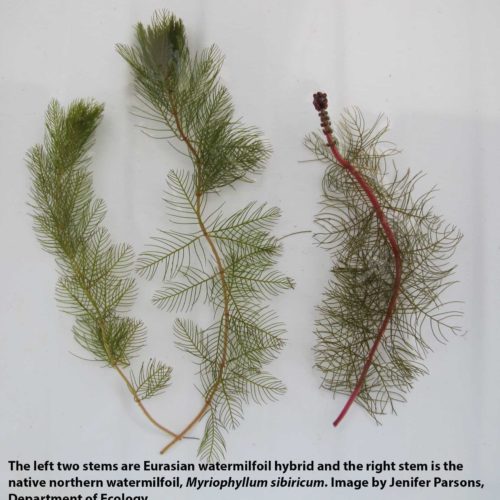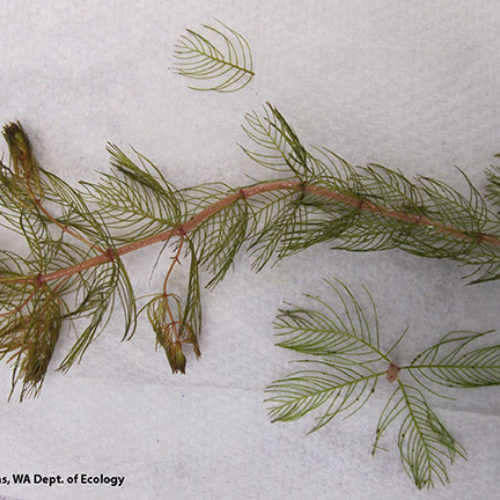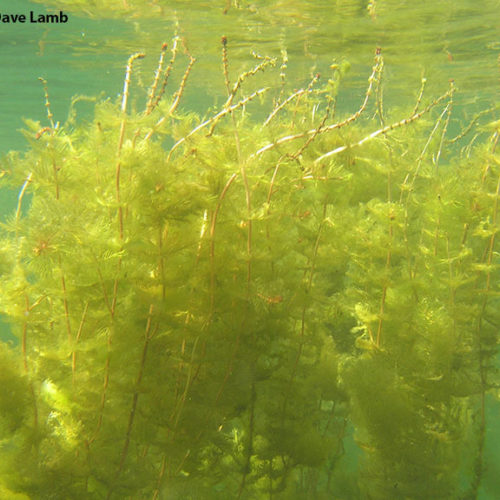Eurasian watermilfoil hybrid
Myriophyllum spicatum x Myriophyllum sibiricum
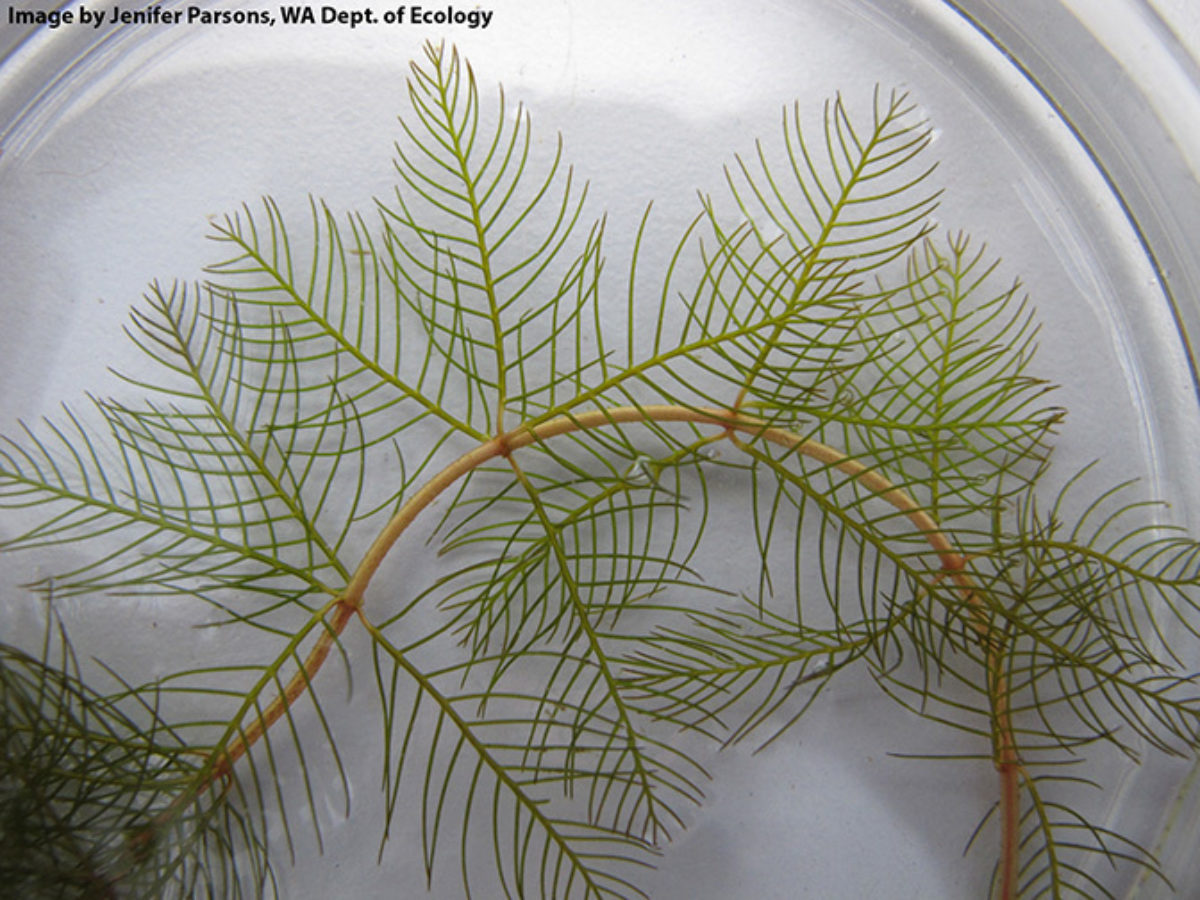
Family: Haloragaceae
Other Common Names: watermilfoil hybrid
Weed class: C
Year Listed: 2018
Is this Weed Toxic?:
not known to be
Why Is It a Noxious Weed?
Eurasian watermilfoil hybrid is a new noxious weed for 2018. This perennial hybrid, a cross between the invasive Eurasian watermilfoil (Myriophyllum spicatum) and the native northern watermilfoil (Myriophyllum sibiricum), can result in a variety of strains--some that are aggressive and tolerant to some herbicide control treatments. Some genetic strains of this hybrid can be even more aggressive than Eurasian watermilfoil. For further information about identifying and controlling Eurasian watermilfoil hybrid, please contact Wesley Glisson with the Washington Department of Ecology.
How would I identify it?
General Description
Eurasian watermilfoil, northern watermilfoil, and Eurasian watermilfoil hybrids all look very similar. All three are submersed perennials with feather-like, submersed leaves. Their flowering stems have small flowers and very small leaf-like bracts that typically rise above the water's surface. Eurasian watermilfoil hybrids have intermediate characteristics, including a variable number of leaflets (also called segments), usually in a range of overlap between the parent species. Identification of the hybrid requires morphological and genetic analysis due to its intermediate characteristics.
Flower Description
Many flowers are borne on an unbranched stalk to 6 inches long, usually rising above the water's surface. On the stalk, female flowers are at the bottom, and male flowers are at the top, with bisexual flowers in between. Flowers usually in whorls of 4. Flowers have 4 sepals and petals that are small, cream to purplish, often deciduous. Flowers are wind pollinated.
Leaf description
Eurasian watermilfoil hybrid has two types of leaves, feather-like, submersed leaves and very small leaf-like bracts on the flowering stem, which typically rise above the water's surface. Leaves with overlapping traits of parents, with submersed leaves having 16 to 28 leaf segments, and being 0.63 to 1.73 inches (16 to 44 mm) long. Click here to see an example.
Stem description
Stems round in cross-section, without hairs, and pale greenish-tan to red in color.
Fruit Seed Description
Rounded fruits with 4 lobes, divides into 4 mericarps (single seeded structures).
May Be Confused With
Parent species: Eurasian watermilfoil, Myriophyllum spicatum, a Class B noxious weed and northern watermilfoil, Myriophyllum sibiricum, a native species in Washington. The following table, by Jenifer Parsons, Dept. of Ecology is from the written findings, page 5, details some of the traits of similar species.
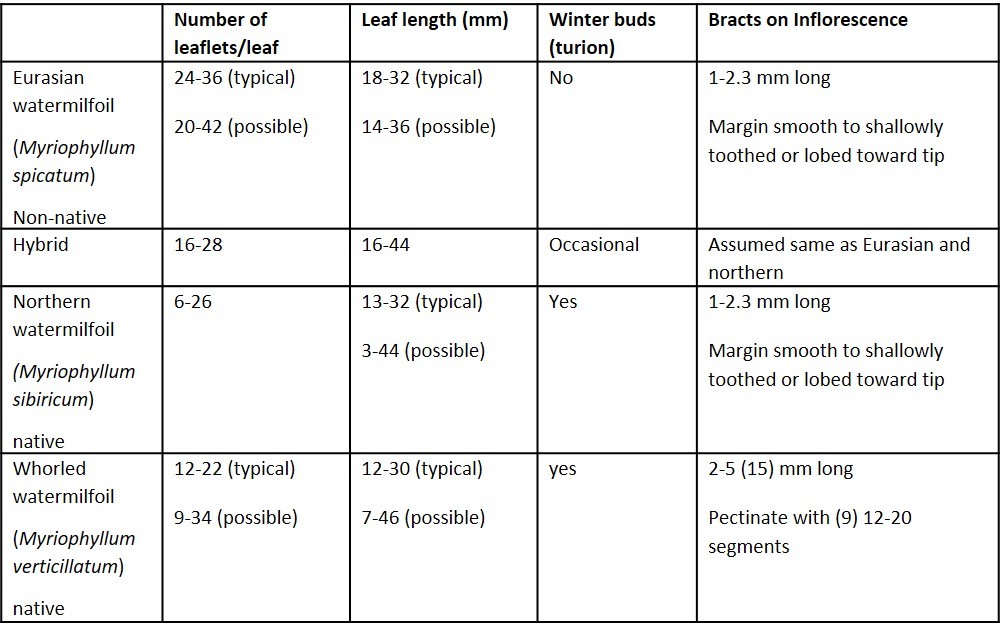
Where does it grow?
Eurasian watermilfoil hybrid is documented in both eastern and western Washington. Click here to see a county-level distribution of Eurasian watermilfoil hybrids in Washington.
How Does it Reproduce?
Eurasian watermilfoil hybrid, like its parents, can reproduce by seed and vegetative reproduction. Vegetative spread is generally considered the major method of reproduction within a waterbody, and is accomplished by three mechanisms: stolons (rhizomes), autofragments and allofragments. Autofragments (common with Eurasian watermilfoil and thought to variably occur with the hybrid) are typically created in late summer when short (15 to 20 cm) sections of the stem tips will develop roots and automatically separate from the parent plants. Allofragments are created by mechanical disturbance of plants such as from wave action or boat propellers. Those broken sections of stem will then form roots and settle to the bottom.
How Do I Control It?
Due to the genetic diversity of Eurasian watermilfoil hybrid, responses to control may vary. The hybrid is a genetically diverse group of many unique crossings and back-crossings, leading to the potential for variable responses to control methods. Both herbicide control response and response to herbivorous insects have been shown to be variable depending on the hybrid strain. Discovery of hybrid strains typically occurs when control methods for Eurasian watermilfoil cease being effective.
Cultural:
Cultural control methods are recommended for controlling Eurasian watermilfoil can also be used on Eurasian watermilfoil hybrid.
Bottom barrier - Covering patches of Eurasian watermilfoil and hybrid watermilfoil with geotextile fabric or other similar woven material can be an effective control method. Make sure to maintain the barrier to prevent establishment of plants on top of the barrier and from gas being trapped beneath the barrier.
Drawdown - Water level reduction to expose plant beds to extended drying or freezing can be an effective hybrid watermilfoil and Eurasian watermilfoil control method. Winter drawdown is the most commonly used method, and will kill existing watermilfoil so long as the plants and
roots freeze.
Mechanical:
These manual and mechanical control methods are recommended and written for controlling Eurasian watermilfoil and can also be used when hybrid watermilfoil is present. All methods of Eurasian watermilfoil and hybrid watermilfoil control that involve physically handling plants require careful containment and removal of plant fragments.
Hand-pulling - Hand-pulling by divers is often used to successfully control or eliminate small populations of Eurasian watermilfoil – either when a population is small or after using another control method such as herbicides to reduce its size. These divers often use a barge-mounted suction hose to take plants from where they are hand-pulling to the boat to increase efficiency. Hand-pulling while wading or snorkeling can be effective in shallow areas so long as the roots are removed and by making sure to collect any fragments.
Cutting and Harvesting - Mechanical harvesters, cutters and raking will generally not remove the roots, so the plants will grow back. These methods also lead to extensive fragmentation, so should only be used where the watermilfoil is already widespread.
Rotovation - Rotovation is like underwater rototilling, and will remove watermilfoil roots. Use of these machines is restricted due to the high level of sediment disturbance.
Biological:
The milfoil weevil, Euhrychiopsis lecontei, while native to the United States, is the most promising insect found to use as a biocontrol on Eurasian watermilfoil, but has been found to have variably results on the Eurasian watermilfoil hybrid.
Triploid grass carp are a non-host specific biocontrol alternative. However, these fish do not prefer Eurasian watermilfoil over native species, so will typically eat the native plants prior to Eurasian watermilfoil, and are not recommended for Eurasian watermilfoil or hybrid watermilfoil control.
Chemical:
Use of pesticides in water is regulated in Washington State. All applicators must have an aquatic endorsement on their pesticide applicators license, which is issued by the Washington Department of Agriculture. In addition, coverage under a permit issued by the Department of Ecology is required. See http://www.ecy.wa.gov/programs/wq/pesticides/index.html for details. Herbicide trials have shown that several products are effective at controlling Eurasian watermilfoil and can also be used on hybrid watermilfoil though the concentration needed may vary due to the hybrid genotype. See our written findings for further information on herbicides for controlling Eurasian watermilfoil hybrid.
For More Information
Please see our written findings for further information about Eurasian watermilfoil hybrid.



